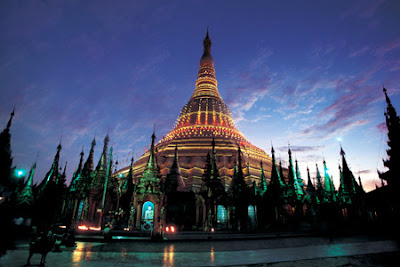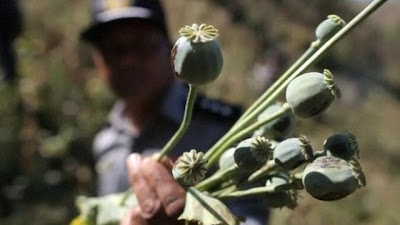ျမန္မာျပည္က ေရႊႏွင့္မူးယစ္ေဆးတုိ႔၏ ၀ိေရာဓိ
ေနသြင္
ေမ ၂၊ ၂၀၁၂
ျမန္မာျပည္က အႀကီးဆံုးၿမိဳ႕ျဖစ္တဲ့ ရန္ကုန္ၿမိဳ႕မွာ စံပယ္ေနတဲ့ ေရႊတိဂံုဘုရားႀကီးကို ဖူးေမွ်ာ္ၾကည္ညိဳဖို႔ တႏွစ္တႏွစ္မွာ ေရာက္လာၾကတဲ့ ဘုရားဖူးပရိသတ္လူေတြက မနည္းပါဘူး။
ေရႊတိဂံု ဘုရားႀကီးက ဉာဏ္ေတာ္အျမင့္ ၈၈ မီတာရွိၿပီး၊ ဘုရားကို ေရႊခ်ထားတဲ့၊ ေရႊစင္ေရႊျပားရဲ႕အေလးခ်ိန္က မက္ထရစ္တန္ခ်ိန္အေနနဲ႔ ၃ တန္ ရွိပါတယ္။ ဂ်ပန္ျပည္ က်ဳိတုိမွာရွိတဲ့ ကင္ကာကူဂ်ီဘုရားေက်ာင္းမွာပူေဇာ္ထားတဲ့ ေရႊအေလးခ်ိန္က ကီလိုဂရမ္ ၂၀ ပဲရွိတယ္ဆုိေတာ့ ဘယ္လိုမွမႏွႈိင္းယွဥ္သာပါဘူး။
 စိန္၊ ပတၱျမားနဲ႔ တျခားေက်ာက္မ်က္ရတနာေပါင္း ၈၀၀၀ ေက်ာ္ကိုလည္း ေစတီေတာ္ႀကီးအတြင္းမွာ ဌာပနာထားပါတယ္။ စိန္ေတြခ်ည္းပဲ အေလးခ်ိန္ ၁၈၀၀ ကာရတ္ရွိၿပီး စိန္ဖူးေတာ္က ၇၆ ကာရက္အေလးခ်ိန္ရွိပါတယ္။
စိန္၊ ပတၱျမားနဲ႔ တျခားေက်ာက္မ်က္ရတနာေပါင္း ၈၀၀၀ ေက်ာ္ကိုလည္း ေစတီေတာ္ႀကီးအတြင္းမွာ ဌာပနာထားပါတယ္။ စိန္ေတြခ်ည္းပဲ အေလးခ်ိန္ ၁၈၀၀ ကာရတ္ရွိၿပီး စိန္ဖူးေတာ္က ၇၆ ကာရက္အေလးခ်ိန္ရွိပါတယ္။ဒါေၾကာင့္ (ဘုရားဆီကျဖာထြက္ေနတဲ့ ေရႊေရာင္၊ စိန္ေရာင္ေတြျဖာထြက္ေနမွႈေၾကာင္႔ ျမန္မာအမ်ဳိးသမီးေတြဟာ ေန႔အလင္းေရာင္မေျပာနဲ႔ ညအေမွာင္ထဲမွာေတာင္ ရင္သက္႐ႈေမာရေလာက္ေအာင္လွတယ္လို႔ အဆုိရွိပါတယ္။
ဒါေပမယ့္ ဘုရားကိုေရႊခ်ထားတဲ့ ေရႊျပားေတြဟာ ကြာက်ကုန္လို႔ မွန္ဘီလူးနဲ႔ အနီးကပ္ဖူးေျမာ္ၾကည့္ရင္ ေစတီေတာ္ႀကီးရဲ႕ကိုယ္ထည္ေပၚမွ ေရႊကြာေနတဲ့ အကြက္အေပ်ာက္ေတြကို အထင္းသားျမင္ရပါတယ္။
“ေလထန္တဲ့အခါ ေရႊျပားေတြ၊ သတၱဳျပားေတြကြာက်၊ လႊင့္က်ကုန္တာေပါ့။ ဆုိင္ကလုန္းတုိက္တဲ့အခါမ်ဳိးဆုိရင္ ေရႊအစအနေတြက အနီး က ေရႊတိဂံုကုန္းေတာ္တ၀ုိက္မွာလႊင့္က်ေနတယ္” လို႔ သာသနာေရး၀န္ႀကီးဌာနက အသက္ ၅၅ ႏွစ္အရြယ္ အရာရွိတေယာက္က ေျပာျပပါ တယ္။
ဒါေၾကာင့္ ဘုန္းေတာ္ႀကီးေတြနဲ႔ေဂါပကေတြကို ေရႊတိဂံုဘုရားကို ရင္ျပင္တ၀ိုက္ကို ထိန္းသိမ္းေစာင့္ေရွာက္ဖို႔၊ ေရႊခ်ထားတဲ့အျပားေတြ၊ ေရႊ စင္ေရႊျပားေတြက အစအနေတြကို ျပန္သိမ္းဆည္းဖို႔ တာ၀န္ေပးထားပါတယ္။
၂၀၀၅ ခုႏွစ္တုန္းက ေရႊတိဂံုေစတီေတာ္ႀကီးကို ျပန္လည္မြမ္းမံတဲ့အခ်ိန္တုန္းက ေရႊခ်ထား တဲ့ ေရႊျပားေတြနဲ႔ ေရႊစင္ေရႊျပာေပါင္း ၄၀၀၀ ကို လင့္ဟာေနတဲ့ေနရာေတြမွာ ျပန္ပူေဇာ္ခဲဲ့ရပါတယ္။ အဲဒီမတုိ္င္ခင္ ၅ ႏွစ္ေလာက္ ျပန္လည္မြမး္မံျခင္းမရွိဘဲ ထားခဲ့တယ္ဆုိေတာ့ ေန႔စဥ္ ဘုရားကိုယ္ထည္ေပၚကေန ေရႊျပားႏွစ္ျပားႏွႈန္း ကြာက်ေနတယ္လို႔ ျပန္တြက္ၾကည့္လို႔ရပါတယ္။
“အကယ္၍ ကြာက်လာတဲ့ေရႊျပားကို တေယာက္ေယာက္ကေကာက္ယူသြားရင္ အဲဒီလူကို အေရးယူအျပစ္ေပးတတ္သလား”လို႔ သာသနာ ေရး၀န္ၾကီးဌာနကအရာရွိကို က်ေနာ္ေမးၾကည့္ေတာ့ အဲဒါမ်ဳိးျဖစ္ရင္ ဘုရားက ေရႊျပားကိုပဲ ျပန္သိမ္းပါတယ္။ ဒါေပမယ့္ ဗုဒၶဘာသာ၀င္ေတြ ကေတာ့ ဘုရားေရႊျပားကိုေတြ႔ရင္ ေဂါပကကိုျပန္အပ္ပါတယ္လို႔ ေျဖပါတယ္။ ဘုရားကေရႊေတြကို သဒၶါတရားထက္သန္တဲ့ ဗုဒၶဘာသာ၀င္ ေတြက လွဴဒါန္းထားၾကတာပါ။
လူေတြေသလြန္တဲ့အခါ ၀ိညာဥ္ဟာ တမလြန္ဘ၀တခုကို ကူးေျပာင္းသြားတယ္ဆုိတဲ့ အယူအဆဟာ ေထရ၀ါဒ ဗုဒၶဘာသာမွာ အေရးႀကီးတဲ့ အယူအဆျဖစ္ပါတယ္။ ျမန္မာျပည္မွာလည္း ေထရ၀ါဒဗုဒၶသာသနာထြန္းကားပါတယ္။ ေထရ၀ါဒကိုးကြယ္သူေတြဟာ ေနာင္ဘ၀မွာ ေကာင္းဖို႔ရည္စူးၿပီး ဘုရား၊ သံဃာေတြကို အလွဴအတန္းေပးရတာကို သဒၶါတရားထက္သန္ၾကပါတယ္၊။
၁၉၈၈ ဒီမုိကေရစီ ဒီေရျမင့္သစ္လွႈပ္ရွားမႈႀကီးအၿပီးမွာ အစိုးရအာေဘာ္သတင္းစာေတြမွာ ထိပ္တန္းစစ္ေခါင္းေဆာင္ေတြက သံဃာေတာ္ေတြကို အလွဴအတန္းျပဳတဲ့သတင္းေတြကို ေဖာ္ျပခဲ့ပါတယ္။ အစိုးရက အႀကီးအက်ယ္၀ါဒျဖန္႔ဖို႔ ရည္ရြယ္ခ်က္နဲ႔ဆုိတာ ေျပာဖို႔ေတာင္မလိုပါဘူး။ ဒါေပမယ့္ ျပည္သူေတြက ဒီသတင္းေတြကို အျပဳသေဘာနဲ႔ပဲ တုန္႔ျပန္ခဲ့ၾကပါတယ္။
“လူေတြက စစ္အစိုးရကို ဘယ္ေလာက္ပဲမုန္းတယ္ဆိုေပမယ့္လည္း အစိုးရအႀကီးအကဲေတြက ဗုဒၶဘာသာကိုၾကည္ညိဳတာကို ေတြ႔ရေတာ့ လည္း လူေတြက သာဓုေခၚၾကတာပါပဲ” လို႔ ဖြ႔ံၿဖိဳးဆဲႏုိင္ငံမ်ား ေလ့လာေရးဌာန Institute of Developing Economies ရဲ႕ အေရွ႕ေတာင္ အာရွေလ့လာေရးအဖြဲ႔ ၂ က ညြန္ၾကားေရးမွဴး တိုရွိဟီရို ကူဒို Toshihiro Kudo က ေျပာပါတယ္။
“အနီေရာင္ရယ္၊ အစိမ္းေရာင္ရယ္၊ အမည္းေရာင္ရယ္၊ ဒီအေရာင္သံုးေရာင္ကိုပိုင္တဲ့လူဟာ ျမန္မာျပည္ကို ထိန္းခ်ဳပ္ႏုိင္မယ္” လို႔ အဆုိရွိတဲ့ အေၾကာင္း စြန္႔စားခန္းေတြအေၾကာင္းေရးတဲ့ စာေရးဆရာ ဟိုက္ဒီ ယူကီ တာကာႏို Hideyuki Takano က ေျပာပါတယ္။ ဒီေနရာမွာ အနီ ေရာင္က ပတၱျမား၊ အစိမ္းေရာင္က ေက်ာက္စိမ္း၊ အမည္းေရာင္ကေတာ့ ဘိန္းကိုဆုိလိုတာပါ။ ျမန္မာျပည္ဟာ ကမၻာမွာ ဘိန္းအမ်ားဆံုးထုတ္ရာ ႏုိင္ငံတႏိုင္ငံလည္း ျဖစ္ပါတယ္။
က်ေနာ့္ရဲ႕ျမန္မာျပည္ခရီးမွာ ရွမ္းျပည္နယ္အေရွ႕ဘက္ျခမ္းက လား႐ႈိးၿမိဳ႕ကိုသြားၿပီး ဘိန္းရွာပံုေတာ္ဖြင့္ခဲ့ပါတယ္။ ဘိန္းဆုိတာက သၾကား လံုးေလးေတြပံုမ်ဳိး၊ အမည္းေရာင္ ဘိန္းသီးေလးေတြကေန ထုတ္တာပါ။ သန္႔စင္လုိက္ရင္ေတာ့ ဘိန္းျဖဴျဖစ္သြားပါတယ္။ ဘိန္းက နဂိုက အမည္းေရာင္ျဖစ္သလုိပဲ၊ ေမွာင္ခိုေစ်းကြက္မွာပဲ လွ်ဳိ႕လွ်ဳိ႕၀ွက္၀ွက္ အေရာင္းအ၀ယ္လုပ္ၾကတဲ့ အမည္းေရာင္နိမိတ္ပံုရွိတဲ့ပစၥည္းလို႔ ဆုိရ မွာပါ။
 ဘိန္းက လူေတြကိုဆြဲေဆာင္ထားပံုနဲ႔ ဘုရားက အထြတ္အျမတ္ထားတဲ့ေရႊေတြက လူေတြကိုဆြဲေဆာင္ပံုကေတာ့ တျခားစီပါ။ ဒါေပမယ့္ ေမာ္ဖင္းလို႔ေခၚတဲ့ နာက်ဥ္မွႈကိုသက္သာေစတဲ့ေဆးကိုလည္း ဘိန္းကပဲထုတ္လုပ္ထားတာပါ။ ဘိန္းကေတာ့ စြယ္စံုသံုး၊ တန္ရင္ေတာ့ေဆး၊ လြန္ရင္ေတာ့ ေဘးျဖစ္ေစတဲ့ အဆိပ္တမ်ဳိးပါပဲ။
ဘိန္းက လူေတြကိုဆြဲေဆာင္ထားပံုနဲ႔ ဘုရားက အထြတ္အျမတ္ထားတဲ့ေရႊေတြက လူေတြကိုဆြဲေဆာင္ပံုကေတာ့ တျခားစီပါ။ ဒါေပမယ့္ ေမာ္ဖင္းလို႔ေခၚတဲ့ နာက်ဥ္မွႈကိုသက္သာေစတဲ့ေဆးကိုလည္း ဘိန္းကပဲထုတ္လုပ္ထားတာပါ။ ဘိန္းကေတာ့ စြယ္စံုသံုး၊ တန္ရင္ေတာ့ေဆး၊ လြန္ရင္ေတာ့ ေဘးျဖစ္ေစတဲ့ အဆိပ္တမ်ဳိးပါပဲ။မူးယစ္းေဆး၀ါးထုတ္လုပ္မွႈနဲ႔ နာမည္ဆုိးနဲ႔ေက်ာ္ၾကားတဲ့ ေရႊႀတိဂံေဒသကေတာ့ ရွမ္းျပည္ေတာင္ပုိင္း၊ ျမန္မာ၊ ထုိင္း၊ လာအုိတို႔ သံုးပြင့္ဆုိင္ နယ္ျခားေဒသျဖစ္ပါတယ္။ ရွမ္းျပည္က တရားမ၀င္ မူးယစ္ေဆး၀ါး ထုတ္လုပ္မႈအေၾကာင္းေျပာရင္ အေမရိကန္ေထာက္လွမ္းေရးေအဂ်င္စီ (စီအုိင္ေအ) ရဲ႕တာ၀န္ကလည္း ေတာ့္ေတာ့္ကိုမကင္းတာပါ။
တ႐ုတ္ကြန္ျမဴနစ္ပါတီကို ႏုိင္ေအာင္မတိုက္ႏို္င္တဲ့ေနာက္မွာ တ႐ုတ္အမ်ဳိးသား၀ါဒီပါတီ၀င္ အႂကြင္းအက်န္ေတြဟာ ရွမ္းျပည္နယ္ကို ထြက္ ေျပးခဲ့ၾကပါတယ္။ သူတို႔ကို ကြန္ျမဴနစ္ဆန္႔က်င္ေရးတပ္အျဖစ္နဲ႔ အေမရိကန္စီအုိင္ေအက ေမြးခဲ့ပါတယ္။ ေထာက္ပံ့ေရးအတြက္ အရင္း အျမစ္အျဖစ္ ဘိန္းကို စီအုိင္ေအကေရြးခ်ယ္ခဲ့ပါတယ္။ စီအုိင္ေအက အဲဒီေဒသကေန ဆုတ္ခြာသြားတဲ့အခါမွာေတာ့ တုိင္းရင္းသားလူမ်ဳိး စုေတြက ဘိန္းလုပ္ငန္းကို လက္ေျပာင္းယူခဲ့ပါတယ္။
ျမန္မာအစိုးရက မူးယစ္ေဆး၀ါးထုတ္လုပ္မွႈ၊ မူူးယစ္ကုန္သည္ေတြကို ႏွိမ္နင္းခဲ့ပါတယ္။ တုိင္းရင္းသားလက္နက္ကုိင္တပ္ေတြကို ထိန္းခ်ဳပ္ ႏိုင္ဖို႔ ရည္ရြယ္ခ်က္နဲ႔ပါ။ တုိင္းရင္းသားတပ္ေတြကို တုိင္းျပည္ၿပိဳကြဲမယ့္အႏၱရာယ္အျဖစ္ အစိုးရကျမင္ပါတယ္။ တနည္းအားျဖင့္ ျမန္မာျပည္ ကို ထိန္းခ်ဳပ္ႏို္င္ဖို႔ အမည္းေရာင္ကိုအႏိုင္တုိက္ဖို႔ ႀကိဳးပမ္းမွႈလို႔ ဆုိႏုိ္င္ပါတယ္။
“ဘိန္းစိုက္ပ်ဳိးေရးက ေတာင္တန္းေဒသက တုိင္းရင္းသားေတြရဲ႕ ခက္ခဲတဲ့ဘ၀ေတြအတြက္ ေငြရွာဖို႔ အလြန္ထိေရာက္တဲ့လမ္းေၾကာင္းပဲ” လို႔ သံတမန္တဦးက ေျပာပါတယ္။ ဒါကိုသိတဲ့အတြက္ အစုိးရကလည္း ဘိန္းအစားထိုးသီးႏွံေတြကိုမစိုက္ႏုိင္ခင္ ၾကားကာလတခုမွာ တုိင္း ရင္းသားေတြ ဘိန္းစိုက္ခ်င္စိုက္ပါေစဆုိၿပီးေတာ့ အတုိင္းအတာတခုအထိ ခြင့္ျပဳထားတာလည္းရွိပါတယ္။
တခ်ိန္တည္းမွာ အစိုးရက တုိင္းရင္းသားတပ္ေတြရဲ႕ တရားမ၀င္ ကာစီႏိုေလာင္းကစားလုပ္ငန္းေတြ၊ ျပည့္တန္ဆာခန္းေတြနဲ႔ နယ္စပ္ကုန္ သြယ္ေရးတို႔လို စီးပြားေရးလုပ္ငန္းေတြကုိလည္း မသိခ်င္ေယာင္ေဆာင္ေနပါတယ္။
ဒီလို ျပန္လည္သင့္ျမတ္ေရးလုပ္ေဆာင္ခ်က္ေတြေၾကာင့္ အစိုးရနဲ႔ တုိင္းရင္းသားလက္နက္ကိုင္တပ္ေတြ အေတာ္မ်ားမ်ား အပစ္ရပ္ေရး လက္မွတ္ထိုးႏိုင္ခဲ့ပါတယ္။ ဒါေပမယ့္ အဲဒီေပၚလစီေတြကို ဦးေဆာင္ကိုင္တြယ္ခဲ့တဲ့ ၀န္ႀကီးခ်ဳပ္ ဗိုလ္ခ်ဳပ္ႀကီးခင္ညႊန႔္ကို လြန္ခဲ့တဲ့ ၇ ႏွစ္က ရာထူးကေန ျဖဳတ္လုိက္တဲ့ေနာက္မွာ အစိုးရဟာ မူးယစ္ေဆး၀ါးထုတ္လုပ္မႈနဲ႔ တရားမ၀င္စီးပြားေရးလုပ္ငန္းေတြကို ခပ္ၾကမ္းၾကမ္းျပန္ၿပီး ကို္င္တြယ္လာပါတယ္။ တုိုင္းရင္းသားတပ္ေတြကို တားဆီးဖို႔ပါ။
အစိုးရနဲ႔တုိင္းရင္းသားတပ္ေတြအၾကားက ထိပ္တုိက္ေတြ႔မွႈေတြ ျပင္းထန္လာတာနဲ႔အမွ် လက္နက္ကိုင္ပဋိပကၡေတြလည္း ပုံမွန္လို ျပန္ျဖစ္ လာပါတယ္။ ရွမ္းျပည္နယ္ထဲက ဘိန္းစိုက္ပ်ဳိးမႈနဲ႔ ဘိန္းထုတ္လုပ္မွႈကလည္း အရင္ထက္ပိုတိုးလာပါတယ္။
“ဒီလိုတုိးလာတာဟာ စစ္ေရးလႈပ္ရွားမႈေတြ ျပင္းထန္လာတာနဲ႔ အမ်ားႀကီးပတ္သက္ပါတယ္” လို႔ သံတမန္က ေျပာပါတယ္။
ကမၻာ့လွည့္ခရီးသြားေတြ အာရံုက်တဲ့ ေရႊႀတိဂံေဒသရဲ႕ လံုျခံဳေရးအေျခအေနကလည္း ဆုိးလားပါတယ္။ က်ေနာ့္ရဲ႕ခရီးစဥ္မွာ အဲဒီေဒသကို သြားဖို႔ အာဏာပိုင္ေတြကခြင့္မျပဳလို႔ မေရာက္လုိက္ရပါဘူး။
အဲဒီေဒသကို ေရႊႀတိဂံလို႔ ေခၚၾကတဲ့ ေနာက္အေၾကာင္းတခုက မူးယစ္ေဆး၀ါးေတြကို ေငြနဲ႔ အေရာင္း အ၀ယ္မလုပ္ၾကပဲ ေရႊနဲ႔ပဲ အလဲအလွယ္လုပ္တာေၾကာင့္လို႔ သိရပါတယ္။ အဲဒီေဒသမွာ ေရႊနဲ႔မူးယစ္ေဆး၀ါးဆုိတာက ဒဂၤါးျပားရဲ႕ ေခါင္းနဲ႔ပန္းလိုပဲ ခြဲျခားလို႔မရေအာင္ပါပဲ။
လား႐ႈိးၿမိဳ႕မွာ ေရာင္စံု႐ုိးရာ၀တ္စံုေတြကို၀တ္ထားတဲ့ အမ်ဳိးသမီးေတြနဲ႔ျပည့္ေနတဲ့ လမ္းအတုိင္းေလွ်ာက္ရင္း ေဆးဆုိင္ေတြ တဆုိင္၀င္ တ ဆုိင္ထြက္ ဘိန္းရွာပံုေတာ္ ဖြင့္ခဲ့ပါတယ္။ ေက်ာနာတာကိုကုတဲ့အခါမွာအသံုးျပဳတဲ့ ဘိန္းပါတဲ့ တုိင္းရင္းေဆးတမ်ဳိးရွိပါသလားလို႔ ဆုိင္ေတြမွာ လုိက္ေမးတဲ့အခါ မရွိဘူးလို႔ခ်ည္း ျပန္ေျဖၾကပါတယ္။
က်ေနာ္နဲ႔လုိက္လာတဲ့ ဧည့္လမ္းညြန္က လား႐ႈိးမွာ ဘိန္းရွာပံုေတာ္ဖြင့္တာကို လက္ေလွ်ာ့လုိက္ဖို႔ စည္း႐ုံးရွာပါတယ္။ လား႐ႈိးက အစိုးရရဲ႕ ထိန္းခ်ဳပ္မွႈေအာက္မွာရွိေနလို႔ပါတဲ့။
တကယ္ေတာ့ လား႐ႈိးမွာ ဘိန္းပါတဲ့ေဆး၀ါးကိုရွာရတာ ျမန္မာျပည္က စာအုပ္ဆုိင္ေတြမွာ ေဒၚေအာင္ဆန္းစုၾကည္ေရးတဲ့စာအုပ္ကို လိုက္ရွာသလိုပါပဲ။ အစိုးရကေတာ့ ဘိန္းကိုေရာ၊ ေဒၚေအာင္ဆန္းစုၾကည္ကိုေရာ၊ ေမွာင္ခုိေလာကရဲ႕ အဆိပ္ရွိတဲ့အရာေတြလို႔ သတ္မွတ္ထား တာပါ။ ဒါေပမယ့္ မၾကာခင္တုန္းကပဲ အစိုးရက ေဒၚေအာင္ဆန္းစုၾကည္ကို ေတြ႔ဆံုေဆြးေႏြးဖို႔ ခ်ဥ္းကပ္လာပါတယ္။
“ျမန္မာျပည္မွာ တုိင္းရင္းသားေတြနဲ႔အစိုးရၾကားမွာ သင့္ျမတ္မွႈရေအာင္ ဆြဲေဆာင္စည္း႐ုံးႏုိင္သူဟာ ဗိုလ္ခ်ဳပ္ေအာင္ဆန္းေသြးပါတဲ့ ေဒၚ ေအာင္ဆန္းစုၾကည္ တေယာက္တည္းပဲရွိတယ္” လို႔ ရန္ကုန္ၿမိဳ႕က အသက္ ၃၅ ႏွစ္အရြယ္ အုိင္တီကုမၼဏီရဲ႕ဥကၠဌက ေျပာပါတယ္။ အ ေၾကာင္းကေတာ့ ဗိုလ္ခ်ဳပ္ေအာင္ဆန္းကိုယ္တုိင္က လူနည္းစုတုိင္းရင္းသားေတြနဲ႔ အစိုးရတို႔ၾကားမွာ သင့္ျမတ္ေရးရဖို႔ အေလးထားလုပ္ ေဆာင္ခဲ့သူျဖစ္ေနလို႔ပါပဲ။
ဒါေၾကာင့္ အစုိးရအေနနဲ႔ “တုိင္းရင္းသားတပ္ေတြ” ဆုိတဲ့အဆိပ္ကို ေအာင္ဆန္းစုၾကည္ဆုိတဲ့အဆိပ္ကိုသံုးၿပီး ထိန္းႏုိင္မလား။ ေဒၚေအာင္ ဆန္းစုၾကည္ကုိယ္တုိင္က ျမန္မာျပည္အတြက္ ေျဖေဆးျဖစ္မလားဆုိတာကေတာ့ စိတ္၀င္စားစရာပါ။
……………..
မုိင္နီခ်ီ ရွင္ဘြန္းမွာပါတဲ့ မူရင္းေဆာင္းပါးျဖစ္ပါသည္။
The contrast between gold and drugs in Myanmar
Takayuki Kasuga (Mainichi Japan)
Shwedagon Pagoda in Yangon, the largest city in Myanmar, has attracted many people over the years to admire its beauty. More than three metric tons of gilts and gold plates are attached to the surface of the 99-meter-high structure. They are far heavier than those attached to Kinkakuji Temple in Kyoto, which weigh 20 kilograms.
Moreover, 80,000 jewels, including diamonds and rubies, are embedded in the structure. The diamonds alone total 1,800 carats, including a 76-carat one at the top of the pagoda.
It is widely said that truly beautiful women are striking in the daytime and also remain stunning even in darkness. However, many parts of the gilts and gold plates that have fallen off its walls look like freckles and blotches if viewed with binoculars.
“If it’s windy, gilts and metal plates can fall off and are blown away. Fragments of gold are often blown across the mountain by cyclones,” says a 55-year-old official with the Ministry of Religious Affairs.
Therefore, monks and servicemen assigned to the pagoda patrol neighboring areas and collect loose fragments of gilts or gold plates. A total of 4,000 gilts and gold plates were replaced when the pagoda was refurbished in 2005 for the first time in five years. That means that on average two of the plates or gilts came off a day over the five-year period.
I asked the official, “If someone picked up gold fragments and stole them, would they be punished?
He replied, “I such a case, we only confiscate the fragments. Ordinary Buddhists who find such fragments usually hand them over to us.”
The gold used for the pagoda was donated by faithful Buddhists.
The transmigration of souls is the core of the concept of life and death for Theravada Buddhism that is prevalent in Myanmar. Followers are enthusiastic about extending donations, which are recognized as merit, to the pagoda and monks in an effort to have a better afterlife. Since pro-democracy movements surged in 1988, state-owned media outlets have reported every single donation that top officials in the military regime extended to monks. Needless to say, it is of a highly propaganda nature. However, the public appears to have reacted positively to such news.
“The public welcomes top officials’ devout adherence to Buddhism even though they hate the military regime,” says Toshihiro Kudo, director of Southeast Asian Studies Group II of the Institute of Developing Economies.
Is Suu Kyi poison or medicine?
It is said that “Those who conquer red, green and black can control Myanmar,” according to adventurer-writer Hideyuki Takano. Red refers to ruby and green is jade, while black means opium. Myanmar is known as one of the world’s largest producers of these items.
I visited Lashio in the eastern state of Shan to look for opium. Opium, made from opium poppies, are black balls that look like candies. They can be made into heroin if purified. Opium is black in terms of its color but also has a dark image as it is an illegal drug traded secretly. The drug attracts many people in a way completely different from that of sacred golden pagodas.
However, morphine that is used as a painkiller can also be extracted from opium. In this area, opium has been regarded as all-purpose cure and can be both medicine and poison.
The so-called Golden Triangle, which became notorious as an area of drug production, is situated in southern Shan and close to Myanmar’s border with Thailand and Laos. The U.S. Central Intelligence Agency (CIA) is responsible largely for making the State of Shan a major supplier of illegal drugs. The CIA supported remnants of the Chinese Nationalist Party — who fled to Sham after losing their fight against the Chinese Communist Party — as an anti-communist front. The CIA chose opium as a source of funding to support them. After the CIA pulled out of the area, ethnic minorities took over the opium concession.
Myanmar’s regime has cracked down on drug producers and traffickers in a bid to contain ethnic minorities’ militias that it fears poses a threat to the unity of the nation. In other words, it was a “fight to conquer ‘black’ to control Myanmar.”
“Growing opium poppies are effective sources of money to support the tough lives of mountain minority tribes,” says a diplomatic source. In view of such circumstances, the regime at one point allowed ethnic minorities to grow opium poppies as an interim measure while trying to enable them to grow substitute agricultural goods. At the time, the regime also gave tacit approval to ethnic minorities’ militias to operate illegal casinos, brothels and trade across national borders.
As a result of these conciliatory moves, the regime reached a cease-fire accord with a majority of armed ethnic minority groups. Seven years ago, the then prime minister who led the conciliatory policy was unseated, and the regime revived its hard-line stance to ban armed ethnic minority groups from producing drugs or operating illegal businesses.
As the confrontation between the government and the militias intensified, armed conflicts have recently occurred sporadically. The amount of opium poppies grown in Shan and opium produced there has increased.
“The rise corresponds with the intensification of the militias’ activities,” says the diplomatic source.
Security in the Golden Triangle, which has become a tourist spot, has worsened and I was unable to gain permission from authorities to enter the area during my latest visit.
I also learned that the area is called “Golden Triangle” because drugs are exchanged for gold, not cash. In fact, drugs and gold are two sides of a coin in the area.
I walked around Lashio, which is full of women dressed in colorful folk costumes, and visited drugstores to ask if they sold traditional medicine containing opium that is effective in curing backaches. However, all storekeepers showed negative reactions.
A tour guide accompanying me tried to persuade me to abandon looking for opium in Lashio “because this area is under government rule.”
Actually, asking drugstores in the area if they have medicine containing opium is just like asking bookstores in Myanmar if they have books authored by Aung San Suu Kyi. The regime regards both opium and Suu Kyi as poisonous existences in the underworld.
However, the regime has recently approached Suu Kyi in a bid to open dialogue. As for the reason for the move, a 35-year-old president of a Yangon-based mobile phone company says, “Suu Kyi, who has Gen. Aung San’s bloodline, is the only person who can persuade ethnic minorities to reconcile with the government (because the general devoted himself to efforts to build up cooperation between the government and ethnic minorities).”
Can the regime control the “poison” of militias with the “poison” of Suu Kyi, and will Suu Kyi become medicine for Myanmar? (By Takayuki Kasuga, Foreign News Department)
(Mainichi Japan) January 24, 2012


မူလ စာေရးဆရာ ရဲ႕ အာေဘာ္၊ အေၾကာင္းအရာေတြတင္မကပဲ ဘာသာျပန္သူက ျမန္မာ ေ၀ါဟာရေတြကို အဆင္ေျပေျပ ေရြးျခယ္ သံုးႏႈန္းပံုပါ ေကာင္းေပတယ္ဗ်ာ။